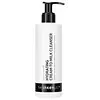What's inside
What's inside
 Key Ingredients
Key Ingredients

 Benefits
Benefits

 Concerns
Concerns

 Ingredients Side-by-side
Ingredients Side-by-side

Water
Skin ConditioningGlycerin
HumectantEthylhexyl Palmitate
EmollientC12-15 Alkyl Benzoate
AntimicrobialPEG-6 Caprylic/Capric Glycerides
EmulsifyingBetaine
HumectantPolyglyceryl-3 Dicitrate/Stearate
EmulsifyingSodium Acrylate/Sodium Acryloyldimethyl Taurate Copolymer
Emulsion StabilisingIsohexadecane
EmollientPentylene Glycol
Skin ConditioningPropanediol
SolventButyrospermum Parkii Butter
Skin ConditioningHydroxyacetophenone
AntioxidantOryza Sativa
Caprylyl Glycol
EmollientCetearyl Olivate
Polysorbate 80
EmulsifyingSorbitan Olivate
EmulsifyingEthylhexylglycerin
Skin ConditioningSodium Hydroxide
BufferingSorbitan Oleate
EmulsifyingXanthan Gum
EmulsifyingHydrolyzed Rice Protein
Skin ConditioningOryza Sativa Bran Oil
EmollientInulin
Skin ConditioningPolyquaternium-10
Hydrolyzed Sodium Hyaluronate
Skin ConditioningSodium Hyaluronate
HumectantPhenoxyethanol
PreservativeLecithin
EmollientWater, Glycerin, Ethylhexyl Palmitate, C12-15 Alkyl Benzoate, PEG-6 Caprylic/Capric Glycerides, Betaine, Polyglyceryl-3 Dicitrate/Stearate, Sodium Acrylate/Sodium Acryloyldimethyl Taurate Copolymer, Isohexadecane, Pentylene Glycol, Propanediol, Butyrospermum Parkii Butter, Hydroxyacetophenone, Oryza Sativa, Caprylyl Glycol, Cetearyl Olivate, Polysorbate 80, Sorbitan Olivate, Ethylhexylglycerin, Sodium Hydroxide, Sorbitan Oleate, Xanthan Gum, Hydrolyzed Rice Protein, Oryza Sativa Bran Oil, Inulin, Polyquaternium-10, Hydrolyzed Sodium Hyaluronate, Sodium Hyaluronate, Phenoxyethanol, Lecithin
Water
Skin ConditioningGlycerin
HumectantLauryl Hydroxysultaine
CleansingSodium Cocoyl Isethionate
CleansingSodium Methyl Cocoyl Taurate
CleansingGlyceryl Stearate Se
EmulsifyingCaprylyl/Capryl Glucoside
CleansingLauryl Betaine
CleansingSodium Chloride
MaskingHydroxypropyl Starch Phosphate
Polyglyceryl-6 Caprylate
EmulsifyingPolyglyceryl-4 Caprate
EmulsifyingTrihydroxystearin
Skin ConditioningGlycol Distearate
Emollient1,2-Hexanediol
Skin ConditioningPolyquaternium-7
Citric Acid
BufferingXanthan Gum
EmulsifyingCetearyl Olivate
Sorbitan Olivate
EmulsifyingAllantoin
Skin ConditioningHydrolyzed Hyaluronic Acid
HumectantArginine
MaskingAspartic Acid
MaskingGlutamic Acid
HumectantSodium Benzoate
MaskingPanthenol
Skin ConditioningWater, Glycerin, Lauryl Hydroxysultaine, Sodium Cocoyl Isethionate, Sodium Methyl Cocoyl Taurate, Glyceryl Stearate Se, Caprylyl/Capryl Glucoside, Lauryl Betaine, Sodium Chloride, Hydroxypropyl Starch Phosphate, Polyglyceryl-6 Caprylate, Polyglyceryl-4 Caprate, Trihydroxystearin, Glycol Distearate, 1,2-Hexanediol, Polyquaternium-7, Citric Acid, Xanthan Gum, Cetearyl Olivate, Sorbitan Olivate, Allantoin, Hydrolyzed Hyaluronic Acid, Arginine, Aspartic Acid, Glutamic Acid, Sodium Benzoate, Panthenol
 Reviews
Reviews

Ingredients Explained
These ingredients are found in both products.
Ingredients higher up in an ingredient list are typically present in a larger amount.
Cetearyl Olivate is an emulsifier and texture enhancer. It is derived from the fatty acids of olive oil and Cetearyl alcohol, and is biodegradable.
As an emulsifier, it is used to prevent oils and waters from separating. It can also
Manufacturers use the name Olivem 1000. This ingredient has been found to preserve the natural microbiome of skin. Having a healthy microbiome helps keep our skin healthy and protects against harmful bacteria. This ingredient is grouped with Sorbitan Olivate under the name Olivem 1000.
Learn more about Cetearyl OlivateGlycerin is already naturally found in your skin. It helps moisturize and protect your skin.
A study from 2016 found glycerin to be more effective as a humectant than AHAs and hyaluronic acid.
As a humectant, it helps the skin stay hydrated by pulling moisture to your skin. The low molecular weight of glycerin allows it to pull moisture into the deeper layers of your skin.
Hydrated skin improves your skin barrier; Your skin barrier helps protect against irritants and bacteria.
Glycerin has also been found to have antimicrobial and antiviral properties. Due to these properties, glycerin is often used in wound and burn treatments.
In cosmetics, glycerin is usually derived from plants such as soybean or palm. However, it can also be sourced from animals, such as tallow or animal fat.
This ingredient is organic, colorless, odorless, and non-toxic.
Glycerin is the name for this ingredient in American English. British English uses Glycerol/Glycerine.
Learn more about GlycerinSorbitan Olivate is created from the fatty acids in olive oil and sorbitol.
This ingredient is an oil in water emulsifier. It helps stabilize a product by preventing oils and waters from separating. Sorbitan Olivate also helps hydrate the skin.
Manufacturers sell sorbitan olivate under the name OliveM 1000. OliveM 1000 a multifunctional ingredient. It is self-emulsifying. According to a manufacturer, OliveM 1000 does not disrupt natural skin biome.
Due to its olive oil base, this ingredient may not be fungal-acne safe.
Learn more about Sorbitan OlivateWater. It's the most common cosmetic ingredient of all. You'll usually see it at the top of ingredient lists, meaning that it makes up the largest part of the product.
So why is it so popular? Water most often acts as a solvent - this means that it helps dissolve other ingredients into the formulation.
You'll also recognize water as that liquid we all need to stay alive. If you see this, drink a glass of water. Stay hydrated!
Learn more about WaterXanthan gum is used as a stabilizer and thickener within cosmetic products. It helps give products a sticky, thick feeling - preventing them from being too runny.
On the technical side of things, xanthan gum is a polysaccharide - a combination consisting of multiple sugar molecules bonded together.
Xanthan gum is a pretty common and great ingredient. It is a natural, non-toxic, non-irritating ingredient that is also commonly used in food products.
Learn more about Xanthan Gum